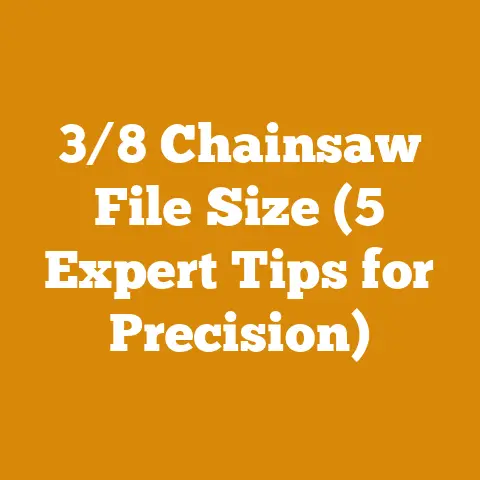Stihl HT101 Carburetor Fixes (5 Pro Tips for Smooth Starts)
It’s always a pain when you’re ready to tackle a job, and your equipment just won’t cooperate. There’s nothing more frustrating than pulling the starter cord on your Stihl HT101 pole saw, only to be met with silence or a sputtering engine. It’s like being all dressed up with nowhere to go, except in this case, you’re all geared up with a tree that needs trimming! In my experience, a finicky carburetor is often the culprit behind these starting woes. Over the years, I’ve wrestled with my fair share of carburetors, and I’ve learned a few tricks that can get your Stihl HT101 running smoothly again. In this article, I’ll share five pro tips for fixing your HT101 carburetor, so you can get back to tackling those overhead branches with confidence. We’ll also delve into the costs associated with keeping your pole saw in top shape, because let’s face it, a well-maintained tool is an investment that pays off in the long run.
Stihl HT101 Carburetor Fixes: 5 Pro Tips for Smooth Starts
The Stihl HT101 pole saw is a fantastic tool for reaching those high branches, but a malfunctioning carburetor can quickly turn it into a frustrating paperweight. These five pro tips will help you diagnose and fix common carburetor issues, getting your HT101 started smoothly every time. We’ll also discuss the costs associated with these fixes, so you can make informed decisions about maintenance and repairs.
1. Fresh Fuel is Your Friend
The Problem: Old fuel is the number one enemy of small engines. Over time, gasoline degrades, losing its volatility and forming gummy deposits that can clog carburetor jets and fuel lines. This is especially true with modern ethanol-blended fuels, which can absorb moisture and cause corrosion.
The Fix: Always use fresh, high-quality fuel. I recommend using premium gasoline with an octane rating of 89 or higher, mixed with a two-stroke oil specifically designed for air-cooled engines. Stihl’s Ultra HP oil is a good choice. Mix the fuel and oil according to the manufacturer’s recommendations (usually 50:1).
Pro Tip: Never store fuel in your HT101 for extended periods, especially during the off-season. Drain the fuel tank and run the engine until it stalls to ensure the carburetor is empty. Consider using a fuel stabilizer like Sta-Bil to prevent fuel degradation during storage.
Cost Breakdown:
- Premium Gasoline: Prices fluctuate, but expect to pay around \$3.50-\$5.00 per gallon, depending on your location.
- Stihl Ultra HP Oil (6.4 oz): Approximately \$8-\$12. A 6.4 oz bottle mixed with 2.5 gallons of gasoline yields a 50:1 ratio.
- Fuel Stabilizer (Sta-Bil): Around \$8-\$10 per bottle. A single bottle can treat up to 20 gallons of fuel.
Data and Statistics:
According to the U.S. Energy Information Administration (EIA), gasoline prices vary significantly by region. As of October 2024, the average retail gasoline price in the U.S. was around \$3.80 per gallon. Using premium gasoline can add an extra \$0.20-\$0.50 per gallon.
Personal Story:
I remember one time I was helping a friend clear some overgrown branches from his property. We spent a good hour trying to get his HT101 started, but it just wouldn’t fire up. After checking everything else, I finally realized the fuel was the culprit. It had been sitting in the can for months and had turned into a thick, gummy mess. We drained the old fuel, mixed up a fresh batch, and the HT101 fired up on the first pull. Lesson learned: fresh fuel is essential!
2. Clean or Replace the Air Filter
The Problem: A dirty air filter restricts airflow to the carburetor, causing a lean fuel mixture and making the engine difficult to start. Over time, dirt, dust, and debris can accumulate on the filter, reducing its effectiveness.
The Fix: Regularly inspect and clean your air filter. If it’s made of foam, wash it with warm soapy water, rinse thoroughly, and allow it to dry completely before re-oiling it with a light coat of air filter oil. If it’s a paper filter, gently tap it to remove loose debris. Replace the air filter if it’s heavily soiled or damaged.
Pro Tip: Clean your air filter after every 25 hours of use, or more frequently in dusty conditions. A clean air filter not only improves starting but also extends the life of your engine.
Cost Breakdown:
- Air Filter Cleaning Supplies (Soap, Water, Air Filter Oil): Minimal cost, typically less than \$5.
- Replacement Air Filter (Stihl HT101): Approximately \$5-\$10.
Data and Statistics:
According to a study by the Equipment Engine & Marketing Association (EEMA), regular air filter maintenance can improve engine performance by up to 10% and extend engine life by up to 20%.
Personal Story:
I once ignored the air filter on my HT101 for far too long. I was busy with other projects and just kept putting it off. Eventually, the engine started running rough and became increasingly difficult to start. When I finally checked the air filter, it was completely clogged with dirt and debris. Replacing the filter made a world of difference, and the engine ran like new again.
3. Inspect and Clean the Spark Plug
The Problem: A fouled or damaged spark plug can prevent the engine from starting. Over time, carbon deposits can accumulate on the spark plug electrodes, reducing its ability to create a strong spark.
The Fix: Remove the spark plug and inspect it for signs of damage or fouling. Clean the electrodes with a wire brush or spark plug cleaner. Check the spark plug gap with a feeler gauge and adjust it to the manufacturer’s specifications (usually around 0.020 inches). Replace the spark plug if it’s heavily worn or damaged.
Pro Tip: Use the correct type of spark plug for your Stihl HT101. Consult your owner’s manual for the recommended spark plug model.
Cost Breakdown:
- Spark Plug Cleaner: Approximately \$5-\$10.
- Spark Plug Gap Tool: Around \$5-\$8.
- Replacement Spark Plug (Stihl HT101): Approximately \$5-\$10.
Data and Statistics:
NGK Spark Plugs, a leading manufacturer, recommends replacing spark plugs every 25-50 hours of use in small engines to maintain optimal performance.
Personal Story:
I had an old chainsaw that was notoriously difficult to start. I tried everything – fresh fuel, cleaned air filter, even a carburetor rebuild. Nothing seemed to work. Finally, on a whim, I decided to replace the spark plug. To my surprise, the chainsaw fired up on the first pull. The old spark plug was so worn that it was barely producing a spark. It just goes to show that even the simplest components can cause major problems.
4. Adjust the Carburetor Settings
The Problem: Incorrect carburetor settings can cause starting problems, poor performance, and excessive fuel consumption. The carburetor controls the air-fuel mixture, and if it’s not properly adjusted, the engine won’t run efficiently.
The Fix: The Stihl HT101 carburetor typically has three adjustment screws:
- L (Low Speed): Controls the fuel mixture at idle and low speeds.
- H (High Speed): Controls the fuel mixture at high speeds.
- LA (Idle Speed): Adjusts the engine’s idle speed.
Caution: Carburetor adjustments should be made carefully and incrementally. Incorrect adjustments can damage the engine.
Procedure:
- Warm up the engine: Let the engine run for a few minutes to reach operating temperature.
- Adjust the L screw: Turn the L screw clockwise until the engine starts to slow down. Then, turn it counterclockwise until the engine starts to run smoothly and accelerates quickly when you open the throttle.
- Adjust the H screw: This screw is usually preset at the factory and should only be adjusted by a qualified technician.
- Adjust the LA screw: Turn the LA screw until the engine idles smoothly without stalling.
Pro Tip: If you’re not comfortable adjusting the carburetor yourself, take your HT101 to a qualified service technician.
Cost Breakdown:
- Carburetor Adjustment Tool: Approximately \$10-\$15.
- Professional Carburetor Adjustment: \$50-\$100, depending on the shop and the complexity of the adjustment.
Data and Statistics:
According to a study by the Outdoor Power Equipment Institute (OPEI), improper carburetor adjustments are a leading cause of small engine problems.
Personal Story:
I once tried to adjust the carburetor on my HT101 without really knowing what I was doing. I ended up making the engine run so lean that it started overheating and eventually stalled. I had to take it to a professional to get it properly adjusted. It was a costly mistake that taught me the importance of knowing my limits.
5. Clean or Rebuild the Carburetor
The Problem: Over time, the carburetor can become clogged with deposits, causing starting problems and poor performance. Small passages and jets within the carburetor can become restricted, preventing the proper flow of fuel.
The Fix: If cleaning the carburetor doesn’t solve the problem, you may need to rebuild it. A carburetor rebuild kit typically includes new gaskets, diaphragms, and needles.
Procedure:
- Remove the carburetor: Disconnect the fuel lines and throttle linkage, and remove the carburetor from the engine.
- Disassemble the carburetor: Carefully disassemble the carburetor, noting the location of all parts.
- Clean the carburetor: Clean all parts with carburetor cleaner. Use compressed air to blow out any remaining debris.
- Reassemble the carburetor: Install the new gaskets, diaphragms, and needles from the rebuild kit.
- Reinstall the carburetor: Reconnect the fuel lines and throttle linkage, and reinstall the carburetor on the engine.
- Adjust the carburetor: Adjust the carburetor settings as described above.
Pro Tip: Take pictures or videos as you disassemble the carburetor to help you remember how everything goes back together.
Cost Breakdown:
- Carburetor Cleaner: Approximately \$5-\$10 per can.
- Carburetor Rebuild Kit (Stihl HT101): Approximately \$15-\$30.
- Professional Carburetor Rebuild: \$80-\$150, depending on the shop and the complexity of the rebuild.
Data and Statistics:
According to a survey of small engine repair shops, carburetor rebuilds are one of the most common repairs performed on outdoor power equipment.
Personal Story:
I once had a chainsaw that was running so poorly that I was convinced it was beyond repair. I decided to try rebuilding the carburetor as a last resort. I bought a rebuild kit, carefully disassembled the carburetor, cleaned all the parts, and reassembled it with the new components. To my amazement, the chainsaw started right up and ran like a champ. It was a challenging but rewarding experience that saved me a lot of money.
Understanding the Costs of Maintaining Your Stihl HT101
Maintaining your Stihl HT101 pole saw involves more than just fixing the carburetor. It’s about understanding the overall costs associated with keeping your tool in top condition. This includes the cost of parts, labor, fuel, and other consumables. By understanding these costs, you can budget effectively and make informed decisions about maintenance and repairs.
Material Costs: Choosing the Right Supplies
The quality of the materials you use can significantly impact the performance and longevity of your Stihl HT101. Using high-quality fuel, oil, and replacement parts can prevent costly repairs down the road.
- Fuel: As mentioned earlier, using fresh, high-quality fuel is crucial. Premium gasoline with an octane rating of 89 or higher is recommended.
- Oil: Use a two-stroke oil specifically designed for air-cooled engines. Stihl Ultra HP oil is a good choice.
- Replacement Parts: When replacing parts, use genuine Stihl parts whenever possible. Aftermarket parts may be cheaper, but they may not meet the same quality standards.
Cost Breakdown:
- Genuine Stihl Parts: Expect to pay a premium for genuine Stihl parts, but they are generally more durable and reliable than aftermarket parts.
- Aftermarket Parts: Aftermarket parts can be a cost-effective alternative, but be sure to research the brand and read reviews before purchasing.
Data and Statistics:
A study by Consumer Reports found that using genuine parts in small engines can extend their lifespan by up to 30%.
Labor Costs: DIY vs. Professional Repair
Deciding whether to tackle repairs yourself or hire a professional is a crucial decision. DIY repairs can save you money on labor costs, but they also require time, skill, and the right tools.
- DIY Repairs: If you’re comfortable working on small engines, DIY repairs can be a great way to save money. However, be sure to consult your owner’s manual and watch videos before attempting any repairs.
- Professional Repair: Hiring a professional technician can be a good option if you’re not comfortable working on small engines or if the repair is complex. However, be prepared to pay for labor costs.
Cost Breakdown:
- Hourly Rate for Small Engine Repair Technicians: Varies by location, but typically ranges from \$60-\$100 per hour.
- DIY Repair Time: Depends on the complexity of the repair and your skill level. Be sure to factor in the time required to diagnose the problem, purchase parts, and perform the repair.
Personal Story:
I’m generally a DIY kind of guy, but there have been times when I’ve had to admit defeat and take my equipment to a professional. One time, I tried to repair the clutch on my chainsaw, but I just couldn’t figure it out. I ended up stripping the threads on the crankshaft and making the problem even worse. I had to take it to a professional, who charged me a hefty sum to fix my mistakes. Lesson learned: know your limits!
Tool Costs: Investing in the Right Equipment
Having the right tools can make maintenance and repairs much easier and more efficient. Investing in a basic set of tools is a worthwhile investment for any small engine owner.
- Basic Tool Set: Includes screwdrivers, pliers, wrenches, sockets, and a multimeter.
- Specialized Tools: May include a carburetor adjustment tool, spark plug gap tool, compression tester, and timing light.
Cost Breakdown:
- Basic Tool Set: Approximately \$50-\$100.
- Specialized Tools: Can range from \$10-\$100 each, depending on the tool.
Data and Statistics:
According to a survey of small engine mechanics, the most commonly used tools are screwdrivers, pliers, wrenches, and sockets.
Other Consumables: Keeping Your HT101 Running Smoothly
In addition to fuel, oil, and replacement parts, there are other consumables that you’ll need to keep your Stihl HT101 running smoothly.
- Chain Oil: Lubricates the chain and bar, reducing friction and wear.
- Grease: Lubricates the gearbox and other moving parts.
- Cleaning Supplies: Includes carburetor cleaner, air filter cleaner, and degreaser.
Cost Breakdown:
- Chain Oil: Approximately \$10-\$20 per gallon.
- Grease: Approximately \$5-\$10 per tube.
- Cleaning Supplies: Approximately \$5-\$10 per can or bottle.
The True Cost of Neglect
Neglecting maintenance can lead to costly repairs down the road. A small problem, like a dirty air filter or a fouled spark plug, can quickly escalate into a major issue if it’s not addressed promptly.
Example:
Ignoring a leaking fuel line can lead to fuel wastage, engine damage, and even a fire hazard. Replacing a fuel line is a relatively inexpensive repair, but neglecting it can result in a much more expensive engine rebuild.
Data and Statistics:
A study by the American Automobile Association (AAA) found that neglecting routine maintenance can increase vehicle repair costs by up to 50%. The same principle applies to small engines.
Budgeting for Your Wood Processing Projects
Now that you have a better understanding of the costs associated with maintaining your Stihl HT101, let’s talk about budgeting for your wood processing projects. Whether you’re harvesting firewood, clearing brush, or trimming trees, it’s important to have a clear understanding of the costs involved.
Estimating Timber Purchase or Harvesting Costs
If you’re purchasing timber, the cost will depend on the type of wood, the quantity, and the location. If you’re harvesting timber from your own property, you’ll need to factor in the cost of equipment, labor, and permits.
Cost Breakdown:
- Timber Prices: Vary widely depending on the species, grade, and location. Contact local lumber yards or logging companies for current prices.
- Equipment Costs: Include the cost of chainsaws, pole saws, log splitters, and other tools.
- Labor Costs: If you’re hiring a logging crew, expect to pay an hourly or per-cord rate.
- Permit Costs: Some areas require permits for harvesting timber. Check with your local authorities.
Data and Statistics:
According to the USDA Forest Service, timber prices fluctuate significantly based on market conditions and regional demand.
Calculating Volume of Logs in Board Feet or Cords
Understanding how to calculate the volume of logs is essential for estimating timber costs and yields.
- Board Feet: A unit of measure for lumber, equal to 144 cubic inches.
- Cords: A unit of measure for firewood, equal to 128 cubic feet.
Formulas:
- Board Feet (Doyle Log Scale): (Small End Diameter in Inches – 4)^2 * Length in Feet / 16
- Cords: (Length in Feet * Width in Feet * Height in Feet) / 128
Example:
A log with a small end diameter of 12 inches and a length of 16 feet would contain approximately (12-4)^2 * 16 / 16 = 64 board feet.
Factoring in Drying Time and Storage Costs
If you’re harvesting firewood, you’ll need to factor in the time it takes for the wood to dry. Seasoned firewood burns more efficiently and produces less smoke.
- Drying Time: Varies depending on the species of wood and the climate. Typically takes 6-12 months.
- Storage Costs: Include the cost of building or purchasing a firewood shed or tarp.
Estimating Drying Time:
Drying time depends on several factors, including wood species, climate, and how the wood is stacked. Hardwoods like oak and maple take longer to dry than softwoods like pine and fir. In general, firewood should be stacked in a single row, off the ground, and covered on top to protect it from rain and snow.
Cost Optimization Tips:
- Choose the right wood species: Some wood species dry faster than others.
- Stack the wood properly: Proper stacking allows for good air circulation, which speeds up the drying process.
- Use a moisture meter: A moisture meter can help you determine when the wood is dry enough to burn.
Optimizing Your Budget
Here are some practical tips for optimizing your budget for wood processing or firewood preparation projects:
- Shop around for the best prices on materials and equipment.
- Consider renting equipment instead of buying it.
- Do as much of the work yourself as possible.
- Take advantage of free resources, such as online tutorials and workshops.
- Plan ahead and avoid last-minute expenses.
- Maintain your equipment properly to prevent costly repairs.
Industry Benchmarks and Statistical Data:
- Average Price per Cord of Firewood: Varies by location, but typically ranges from \$200-\$400 per cord.
- Equipment Rental Fees: Depend on the type of equipment and the rental period. Contact local rental companies for current rates.
Case Studies: Real-World Budgeting Examples
Let’s take a look at a couple of real-world case studies to illustrate how to budget for wood processing projects.
Case Study 1: Firewood Harvesting for Home Heating
Project: Harvesting 5 cords of firewood for home heating.
Assumptions:
- Harvesting timber from own property.
- Using a Stihl HT101 pole saw and a log splitter.
- DIY labor.
Cost Breakdown:
- Equipment Maintenance (Stihl HT101 and Log Splitter): \$50
- Fuel and Oil: \$100
- Chain Oil: \$20
- Permits (if required): \$50
- Total Estimated Cost: \$220
Analysis:
In this case, the majority of the cost is for fuel, oil, and equipment maintenance. By doing the work yourself and harvesting timber from your own property, you can significantly reduce the cost of firewood.
Case Study 2: Clearing Brush for Landscaping
Project: Clearing 1 acre of brush for landscaping.
Assumptions:
- Hiring a landscaping crew.
- Using a Stihl HT101 pole saw and a brush cutter.
- Disposing of brush at a local landfill.
Cost Breakdown:
- Landscaping Crew (8 hours at \$50/hour): \$400
- Equipment Rental (Brush Cutter): \$50
- Disposal Fees: \$100
- Total Estimated Cost: \$550
Analysis:
In this case, the majority of the cost is for labor. By hiring a landscaping crew, you can save time and effort, but you’ll need to factor in the cost of labor.
Actionable Takeaways and Next Steps
By now, you should have a good understanding of the costs associated with maintaining your Stihl HT101 pole saw and budgeting for wood processing projects. Here are some actionable takeaways and next steps:
- Prioritize maintenance: Regular maintenance can prevent costly repairs and extend the life of your equipment.
- Track your expenses: Keep track of your expenses to identify areas where you can save money.
- Plan ahead: Plan your projects carefully and avoid last-minute expenses.
- Shop around for the best prices: Compare prices from different suppliers and rental companies.
- Don’t be afraid to ask for help: If you’re not sure how to do something, ask a professional or consult online resources.
Conclusion
Maintaining your Stihl HT101 and budgeting for wood processing projects can seem daunting, but with a little knowledge and planning, you can save money and get the job done right. Remember to prioritize maintenance, track your expenses, and plan ahead. By following these tips, you can keep your equipment running smoothly and achieve your wood processing goals. Now, go forth and conquer those overhead branches! Just remember to keep that fuel fresh and those carburetors clean!






